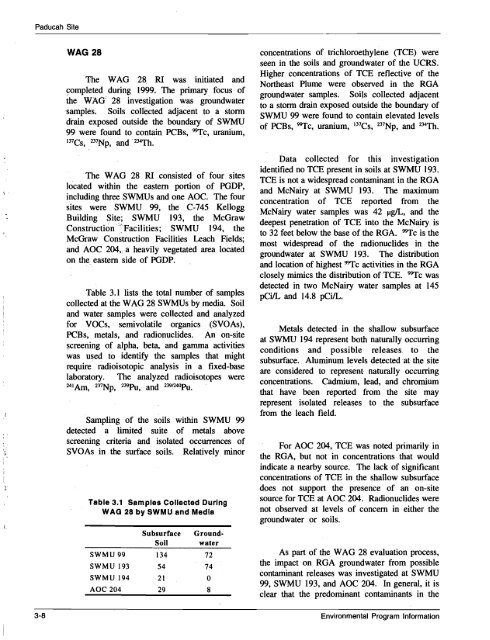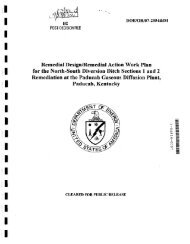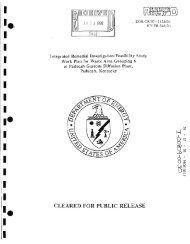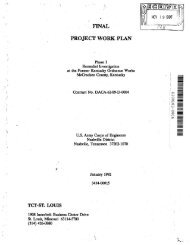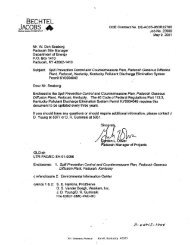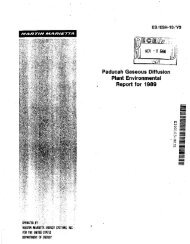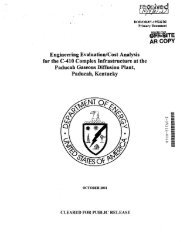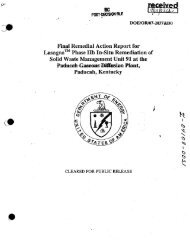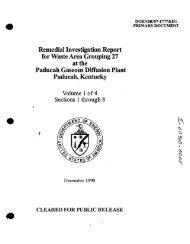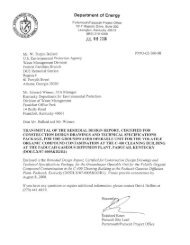1 - paducah environmental information center
1 - paducah environmental information center
1 - paducah environmental information center
You also want an ePaper? Increase the reach of your titles
YUMPU automatically turns print PDFs into web optimized ePapers that Google loves.
Paducah Site<br />
.<br />
,<br />
,.<br />
.'i<br />
WAG 28<br />
17he WAG 28 RI was initiated and<br />
completed during 1999, The primary focus of<br />
the WAG' 28 investigation was groundwater<br />
samples, Soils .collected adjacent to a storm<br />
dfain exposed outside the boundary of SWMU<br />
99 were found to contain PCBs, 99'[c, uranium,<br />
J37Cs, 237.Np, and 234Th.·<br />
The WAG 28 RI consisted of four sites<br />
located within the eastern portion of PGDP,<br />
including three SWMUs and one AOC. The four<br />
sites were SWMU 99, the C-745 Kellogg<br />
Building Site; SWMU 193, the McGraw<br />
Construction ";Facilities; SWMU 194, the<br />
McGraw Construction Facilities Leach Fields;<br />
and AOC 204,a heavily vegetated area located<br />
on the eastern side of PGDP.<br />
Table 3.1 lists the total number of samples<br />
collected at the WAG 28 SWMUs by media. Soil<br />
and water samples were collected and analyzed<br />
for . VOCs, semivolatile organics (SVOAs),<br />
PCBs, metals, and radionuclides. An on-site<br />
screening of alpha, beta, and 'gamma activities<br />
was used to identify the' samples that might<br />
require radioisotopic analysis in a fixed-base<br />
laboratory. The analyzed radioisotopes were<br />
241 Am, 237Np, 239Pu, and 2391240Pu.<br />
Sampling of the soils within SWMU 99<br />
detected a limited suite of metals above<br />
screening criteria and isolated occurrences of<br />
SVOAs in the surface soils. Relatively minor<br />
Table 3.1 Samples Collected During<br />
WAG 28 by SWMU and Media<br />
Subsurface Ground·<br />
Soil water<br />
SWMU 99 134 72<br />
SWMU 193 54 74<br />
SWMU 194 21 0<br />
AOe 204 29 8<br />
concentrations of trichloroethylene (TCE) were<br />
seen in the soils and groundwater of the UCRS.<br />
Higher concentrations of TCE reflective of the<br />
Northeast Plume were observed in the RGA<br />
groundwater samples. Soils collected adjacent<br />
to a storm drain exposed outside the boundary of<br />
SWMU 99 were found to contain elevated levels<br />
of PCBs, 99Tc, uranium, mCs, 237Np, and 234Th.<br />
Data collected for this investigation<br />
identified no TCE present in soils at SWMU 193.<br />
TCE is not a widespread contaminant in the RGA<br />
and McNairy at SWMU 193. The maximum<br />
concentration of TCE reported from the<br />
McNairy water samples was 42 fJg/L, and the<br />
deepest penetration of TCE into the McNairy is<br />
to 32 feet below the base of the RGA. 99Tc is the<br />
most widespread of the radionuclides in the<br />
groundwater at SWMU 193. The distribution<br />
and location of highest WTc activities in the RGA<br />
closely mimics the distribution of TCE. WTc was<br />
detected in two McNairy water samples at 145<br />
pCiIL and 14.8 pCiIL.<br />
Metals detected in the shallow subsurface<br />
at SWMU 194 represent both naturally occurring<br />
conditions and possible releases to the<br />
subsurface. Aluminum levels detected at the site<br />
are considered to represent naturally occurring<br />
concentrations. Cadmium, lead, and chromium<br />
that have been. reported from the site may<br />
represent isolated releases to the subsurface<br />
from the leach field.<br />
For AOC 204, TCE was noted primarily in<br />
the RGA, but not in concentrations that would<br />
indicate a nearby source. The lack of significant<br />
concentrations of TCE in the shallow subsurface<br />
does not support the presence of an on-site<br />
source for TCE at AOC 204. Radionuclides were<br />
not observed at levels of concern in either the<br />
groundwater or soils.<br />
As part of the WAG 28 evaluation process,<br />
the impact on RGA groundwater from possible<br />
contaminant releases was investigated at SWMU<br />
99, SWMU 193, and AOC 204. In general, it is<br />
clear that the predominant· contaminants in the<br />
3-8<br />
Environmental Program Information


